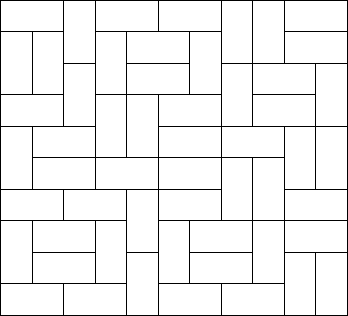Mondriaan's Dream
| Time Limit: 3000MS | Memory Limit: 65536K | |
| Total Submissions: 16037 | Accepted: 9283 |
Description
Squares and rectangles fascinated the famous Dutch painter Piet Mondriaan. One night, after producing the drawings in his 'toilet series' (where he had to use his toilet paper to draw on, for all of his paper was filled with squares and rectangles), he dreamt of filling a large rectangle with small rectangles of width 2 and height 1 in varying ways.

Expert as he was in this material, he saw at a glance that he'll need a computer to calculate the number of ways to fill the large rectangle whose dimensions were integer values, as well. Help him, so that his dream won't turn into a nightmare!

Expert as he was in this material, he saw at a glance that he'll need a computer to calculate the number of ways to fill the large rectangle whose dimensions were integer values, as well. Help him, so that his dream won't turn into a nightmare!
Input
The input contains several test cases. Each test case is made up of two integer numbers: the height h and the width w of the large rectangle. Input is terminated by h=w=0. Otherwise, 1<=h,w<=11.
Output
 For each test case, output the number of different ways the given rectangle can be filled with small rectangles of size 2 times 1. Assume the given large rectangle is oriented, i.e. count symmetrical tilings multiple times.
For each test case, output the number of different ways the given rectangle can be filled with small rectangles of size 2 times 1. Assume the given large rectangle is oriented, i.e. count symmetrical tilings multiple times.
Sample Input
1 2 1 3 1 4 2 2 2 3 2 4 2 11 4 11 0 0
Sample Output
1 0 1 2 3 5 144 51205
Source
题意:略。思路:略。
待优化。
# include <stdio.h>
# include <string.h>
# define LL long long
const int MAXN = (1<<11)+1;
LL dp[MAXN], tmp[MAXN];
bool ok[MAXN];
int a, b, up;
bool judge(int i)
{
while(i)
{
if(i&1)
{
i >>= 1;
if(!(i&1))
return false;
i >>= 1;
}
else
i >>= 1;
}
return true;
}
void init()
{
memset(ok, false, sizeof(ok));
memset(tmp, 0, sizeof(tmp));
for(int i=0; i<up; ++i)
if(judge(i))
{
ok[i] = true;
tmp[i] = 1;//首行必须要相邻的1,或者没1。
}
}
LL fun()
{
for(int i=2; i<=a; ++i)
{
memset(dp, 0, sizeof(dp));
for(int j=0; j<up; ++j)
for(int k=0; k<up; ++k)
{
if(!tmp[k] || (j|k)!=up-1)
continue;
if(!ok[j&k])//上下两种状态按位与后必须要有两个相邻的1,或者没有1。
continue;
dp[j] += tmp[k];
}
for(int i=0; i<up; ++i)
tmp[i] = dp[i];
}
return dp[up-1];
}
int main()
{
while(~scanf("%d%d",&a,&b),a+b)
{
if((a*b)&1)
{
puts("0");
continue;
}
if(a < b)
{
int c = a;
a = b;
b = c;
}
up = 1<<b;
init();
printf("%lld\n",fun());
}
return 0;
}







 本文探讨了如何使用计算机计算填充矩形的不同方式的数量。通过动态规划算法解决了一个经典问题,即用2×1的小矩形填充大矩形。
本文探讨了如何使用计算机计算填充矩形的不同方式的数量。通过动态规划算法解决了一个经典问题,即用2×1的小矩形填充大矩形。
















 253
253

 被折叠的 条评论
为什么被折叠?
被折叠的 条评论
为什么被折叠?








